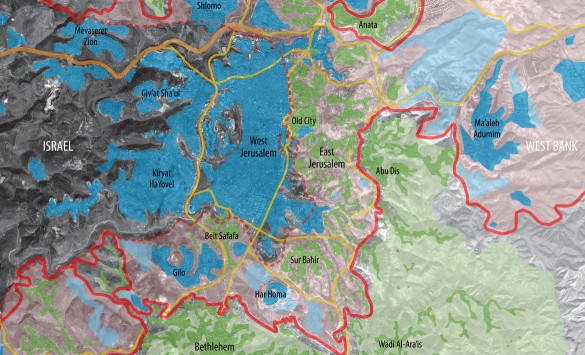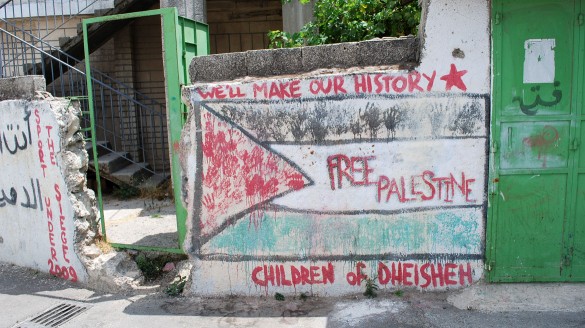by Ahmad Barclay
An article published in the Società Italiana di Scienze Psicosociali per la Pace (Italian Society of Psycho-Social Sciences for Peace) journal “Pace, Conflitti e Violenza”, featured on this site last week.
(Republished on arenaofspeculation.org with permission from the author.)

My personal interest in the spatial politics of Israel-Palestine was kindled through long standing family connections with Jerusalem, and a consequent desire to understand the malevolent role of architecture – my own chosen profession – in shaping the seemingly both irreconcilable and indivisible built environment that now exists. I became fascinated by the question of how the material tools of architecture and spatial planning might also be harnessed as a catalyst for transformative processes running counter to these prevailing forces, and it seemed that these were exactly the ideas that Decolonising Architecture (DA) was grappling with through its work.
Having been engaged in the Palestine advocacy networks in the UK, I came to Beit Sahour (Bethlehem) in the summer of 2009 with certain pre-conceived ideas about the political landscape of the Palestinian territories. I was aware of the divisions among the major political factions, and of the increasing disengagement from these among the wider population, yet had believed that political activism at a grassroots level had more than filled this void, particularly in the West Bank. In some sense, I had anticipated visible signs of transformation on the ground allied to the exponential growth in international support for the Palestinian cause. Yet, whilst the people demonstrate an incredible resilience in finding ways to live in the day to day – to get by, to enjoy life, even to prosper – the underlying reality was an almost tangible air of hopelessness about the future, fuelled by Israel’s embedded and seemingly irreversible control over almost every aspect of Palestinian life, and a lack of any credible political horizon towards which to build.
I would describe the DA summer programme in 2009 as a mixture of academic research, conflict tourism, voyeurism, social networking, intellectual discourse and, ultimately, the production of beautiful objects. The experience hovered in an almost surreal state of tension between ‘research’ and ‘production’; between surveying the politically and emotionally charged environment around us, and generating architectural content in an office environment seemingly disembodied from these surrounds. This tension was perhaps amplified by the challenge of forming a coherent working unit from an international cohort of individuals with varying levels of architectural experience and understanding of the geopolitical context of Israel-Palestine.

Broadly, I would describe the approach of DA as adopting ‘spatial conjecture’ as a tool of opposition, a ‘critical speculation’ that is neither dogged by the constraints of the contemporary political situation, nor entirely naïve about the real and present challenges that exist. The paradigm is therefore not one of offering utopian ‘solutions’ (DA are explicit about this fact), but of using projects as lenses through which to expose the paradoxes and absurdities of the present situation – the ultimate fragility of Israel’s hegemony – and to open an alternative realm of critical debate and practice (what DA describe as an ‘arena of speculation’) with the potential to lead political processes, rather than to simply inhabit the straitjacket imposed by the self-referential logic of the ‘peace process’.
I found my own experience with DA tinged with equal measure of intellectual insight and frustration. I felt that, in itself, the opportunity to inhabit the network of academics and activists that DA are engaged with made participation in the programme a hugely valuable experience. However, to engage with such vast and complex issues as the Palestinian refugee question, only to have to distil these into an ‘exhibit’ for the consumption of a narrow arts audience on another continent felt like a hollow outcome, dislocated from the possibilities implicit in the research itself. It is as if to hand pick all of the ingredients of the finest cuisine, and then put them in a blender and feed them to a goat.
The preceding analogy is an attempt to caricature the potential limitations of the present forums that exist, rather than the limitations of the work itself. The work of DA has already been successful in spreading its distinctive ‘arena of speculation’ into the realms of architectural theory and visual culture. However, presently there is a substantial void between this realm of critical speculation and the potential frameworks for a realisation of its imaginings; between the small windows of opportunity for intervention on the ground, and the distant horizon of a genuine physical and intellectual space of coexistence. In a sense, a mere proliferation of conjecture is likely to lead into a new intellectual cul-de-sac at the point where the possibilities for ‘original’ ideas dry up, unless it manages to reconnect with the agents and dynamics of political transformation – both on the ground and in the international arena – from which it takes its cues.

In a sense, I saw my own research as an opportunity to bring these questions into sharper focus. Where does DA’s framework of ‘critical speculation’ figure as a form of agency within a wider spectrum of ‘spatial resistance’? And what are the potentials for these forms of ‘spatial intervention’ in influencing and shaping the overarching political struggle? The initial outcome has been my dissertation, now published online under the title ‘Resisting Spaciocide: Notes on the Spatial Struggle in Israel-Palestine’, which offers an attempt to frame ‘spatial resistance’ within the spatio-political landscape of Israel-Palestine. Through dialogue with a range of individuals and organisations on both sides of the Green Line, it attempts to define a series of ‘modes’ of spatial resistance, and to formulate the potential ways in which these begin to form a coherent movement towards a new spatio-political horizon.
I would argue that this is one of the major challenges in the Palestinian political and intellectual space today. To construct such a horizon that might inspire a mass re-engagement at a grassroots level, in the absence of any meaningful direction from the PLO, and in the shadow of the Palestinian Authority (an entity that, in itself, remains an artefact of Israel’s occupation). Internationally, it seems the tide has already turned, and the real question is not whether the dynamics of power on the ground can be transformed, but instead what shape this inevitable transformation will take? And what will be its consequences? Are we doomed to see an amplification of violence and the hardening of divisions as the uncompromising forces of an ethnocentric nationalism throw their final dice? Or could we see a less turbulent transition towards a space of coexistence grounded in justice and reconciliation?
In this realm of thought, the challenge that we face as architects and spatial thinkers is to position ourselves within the strategic dialogue on the spatial futures of Israel-Palestine, both at a local and international level. DA has already done much to engage in the local arena, through collaborations with various NGOs, an ongoing dialogue with Birzeit University, and the establishment of the Center for Architecture Media and Politics (CAMP) with Al-Quds University. Perhaps these academic programmes in particular will begin to empower a new generation of Palestinians with the necessary tools to bring this critical spatial thinking to the heart of the Palestinian political sphere.

Within the realm of international ‘civil society’, it is perhaps the role of DA’s extended network of participants to each engage as ‘actors’ at their own local level. There are already many academic connections, particularly within Europe, but the interaction with political advocacy groups apparently remains limited. The spatial dimensions of the conflict loom large in this arena – in the endless proliferation of maps, and the iconography of the ‘Wall’ – yet there is a lack of understanding of the potential fragility of the present spatial regime, and the ways in which various forms of action and advocacy can not only undermine its power base but also help to lay the foundations of something else. As ‘academics’ and ‘professionals’ in the fields of architecture and spatial thinking, we should not underestimate the potential weight that our ideas have in influencing the shape of such agency.
It is another outcome linked to my research, the website arenaofspeculation.org, which can perhaps contribute in a small way to this sphere of agency. The name is intentionally borrowed from DA’s lexicon, underlining its association with this genealogy of thought. It is conceived as a collaborative and ‘open-source’ platform for illuminating and reinforcing the growing arena of ‘spatial resistance’, for cultivating stronger connections between the realm of ‘critical speculation’ and the networks of ‘advocacy’ and ‘spatial intervention’ that are capable of constructing a path towards a different spatial future.

2 replies on “Can ‘Spatial Resistance’ be Harnessed as a Tool to Redefine a Political Landscape?”
thank you for an excellent insight in to your work and current political climate Ahmad
i wonder would you be able to expand briefly on the open source nature of the projects and how information is documented and shared for others to build upon?
At this stage ‘open source’ is more of an ideal that we’re aiming towards than a structured set of practices.
A problem we see is that there are lots of people around the world looking at this topic, documenting valuable ideas and actions that are taking place, yet their work is often buried in academic journals, conference papers and the like, so these ideas don’t necessarily reach a wider audience where they might be digested, built upon and inform practice.
So, one of our aims is to have a place where such academic work – along with other features and projects rooted in activism – can be brought into the public domain. And an important way we’re doing this is by encouraging people to share their work under Creative Commons licenses that allow for flexibility in how content can be redistributed, modified and built upon (for example, see ‘research>publications’ section).